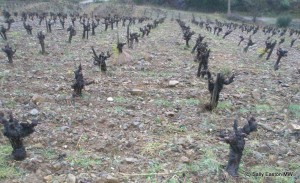Saint Chinian
A version of this first appeared in Hampshire View, May 2013.

Old vines, schist soil
Appellation is a complex thing in France. Even that most illustrious and prestigious region Bordeaux is not homogenous – altitude varies, grape varieties vary (within a prescribed range), soils vary from deep gravels on the left bank, clay over limestone on the right bank, and various amounts of sands over quite a lot of the place. One shouldn’t really be surprised to find equivalent diversity of natural factors in other appellations.
St Chinian, 20 miles north-west of Beziers, and deep-set in the Languedoc foothills of the Black Mountains, is one such appellation.
Altitude also varies – from around 100 to 400m. There’ll be a significant cooling influence higher up. Grape varieties also vary – around 90% of production is red (same as Bordeaux), but here the ‘big four’ are grenache, lledoner pelut, mourvèdre and syrah, plus supporting action from cinsault, and carignan. The few whites are made mainly of grenache blanc, marsanne, roussanne and rolle, and can be of very good quality.
Soil also varies. There are two broad geological divisions in Saint-Chinian, divided by the rivers Orb and Vernazobres, with clay and limestone to the south and schist to the north. We are told that schist gives tighter tannins, while limestone gives fatter and rounder tannins. We are told that wines tend to have lower acidity on the schist compared to the limestone. But schist is found at the higher (cooler, fresher) altitude, so any loss of acidity due to the schist is compensated for by the higher acidity conferred by higher altitude.
Wine style also varies – from the quotidian to the aspirational (another similar point of comparison with Bordeaux, then). And the flavour of the garrigue – thyme, rosemary, bay, mint, fennel, pine etc – is said to uniquely infuse the wine, especially the reds, across much of Languedoc.
How do you navigate such diversity? With pleasure, has to be the slightly facetious answer. Some producers grow individual grape varieties on different soils. Others grow all the varieties on the same soil. The wines are blended in widely different proportions. Winemaking with new oak varies from none to a lot, and the latter can significantly mask varietal or ‘terroir’ flavour effects. It’s virtually impossible to draw any generalisations. The prosaic conclusion, as with most places, is to find some producers who make the sorts of wines you like the flavour of and go from there.
These are just a few I rate:
Domaine Les Eminades, Cebenna, 2011, Saint Chinian, £12.99, Cambridge Wine Merchants
Syrah, mourvèdre, grenache. Revels in an uncomplicated nature of juicy strawberry and cranberry fruits, tasty wine with plenty of structured fruit volume.
Château la Dournie, Elise 2009, Saint-Chinian, £14.75, Leon Stolarski Fine Wines
80% syrah, 20% grenache on schist. Fragrant smoke and berry perfume, freshness and lift to the medium body weight ; spiciness and concentration to the red berry fruit flavours.
Mas de Cynanque, Acutum 2009, Saint-Chinian, £14.99, Cambridge Wine Merchants
60% syrah, 20 mourvèdre, 20 grenache on clay limestone. Bramble, graphite with bitter chocolate over toasted forest fruits. Big, broad-shouldered frame contrasts with comparative elegance of la Dournie. Interesting style differential.
Domaine Navarre, Cuvee Olivier, 2010, Saint Chinian, £18.99, Caves de Pyrenes
Old carignan and syrah, with grenache. Perfumed, bright fruits, good concentration in medium body.



